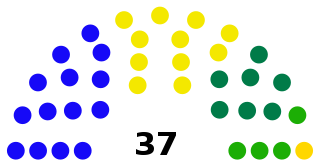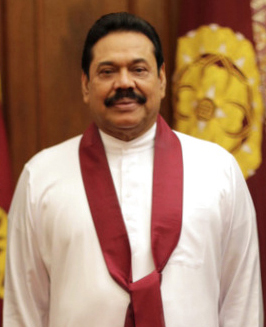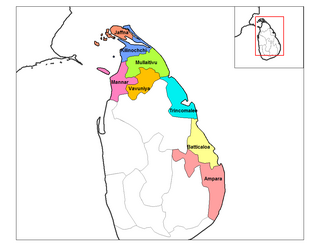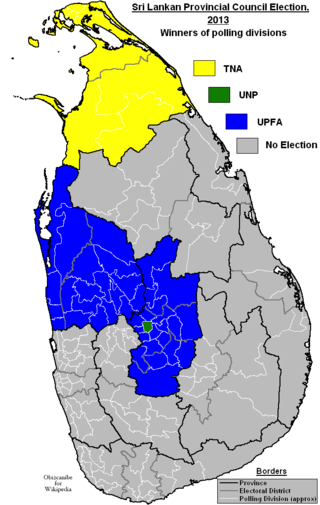The Eelam People's Revolutionary Liberation Front (EPRLF) is a series of Sri Lankan political parties and a former militant separatist group.

The North Eastern Province was one of the provinces of Sri Lanka. The province was created in September 1988 by merging the Northern and Eastern provinces. This merger was declared illegal by the Supreme Court of Sri Lanka in 2006. The province was formally demerged into the Northern and Eastern provinces on 1 January 2007. The capital of the province was Trincomalee.
Vanni Electoral District is one of the 22 multi-member electoral districts of Sri Lanka created by the 1978 Constitution of Sri Lanka. The district covers the administrative districts of Mannar, Mullaitivu and Vavuniya in the Northern province. The district currently elects 6 of the 225 members of the Sri Lankan Parliament and had 253,058 registered electors in 2014. The district is Sri Lanka's Electorate Number 11.

The Eastern Provincial Council is the provincial council for the Eastern Province in Sri Lanka. In accordance with the Sri Lankan constitution, EPC has legislative power over a variety of matters including agriculture, education, health, housing, local government, planning, road transport and social services. The constitution also gives it powers over police and land but successive central governments have refused to devolve these powers to the provinces. EPC has 37 members elected using the open list proportional representation system.
Trincomalee Electoral District is one of the 22 multi-member electoral districts of Sri Lanka created by the 1978 Constitution of Sri Lanka. The district is conterminous with the administrative district of Trincomalee in the Eastern province. The district currently elects 4 of the 225 members of the Sri Lankan Parliament and had 246,890 registered electors in 2010. The district is Sri Lanka's Electorate Number 14.

Sri Lanka has held several rounds of Provincial Council elections in 2008 and 2009 to elect members to eight of the country’s Provincial Councils. The decision to hold elections in different parts of the country on separate days was a break in the usual practice, which is to hold elections for the whole country on the same day. For each provincial council, members are elected to serve a five-year term. A chief minister for the province is chosen by the elected members.

Provincial Council elections were held on 19 November 1988 to elect members to Sri Lanka’s North Eastern Provincial Council.
Colombo Electoral District is one of the 22 multi-member electoral districts of Sri Lanka created by the 1978 Constitution of Sri Lanka. The district is conterminous with the administrative district of Colombo in the Western province. The district currently elects 19 of the 225 members of the Sri Lankan Parliament and had 1,765,351 registered electors in 2024. The district is Sri Lanka's Electorate Number 01.
Gampaha electoral district is one of the 22 multi-member electoral districts of Sri Lanka created by the 1978 Constitution of Sri Lanka. The district is conterminous with the administrative district of Gampaha in the Western province. The district currently elects 19 of the 225 members of the Sri Lankan Parliament and had 1,785,964 registered electors in 2020. The district is Sri Lanka's Electorate Number 02.
Kalutara electoral district is one of the 22 multi-member electoral districts of Sri Lanka created by the 1978 Constitution of Sri Lanka. The district is conterminous with the administrative district of Kalutara in the Western province. The district currently elects 10 of the 225 members of the Sri Lankan Parliament and had 813,233 registered electors in 2010. The district is Sri Lanka's Electorate Number 03.
Kandy (Mahanuwara) electoral district is one of the 22 multi-member electoral districts of Sri Lanka created by the 1978 Constitution of Sri Lanka. The district is conterminous with the administrative district of Kandy in the Central province. The district currently elects 12 of the 225 members of the Sri Lankan Parliament and had 970,456 registered electors in 2010. It is Sri Lanka's Electorate Number 04.
Matale electoral district is one of the 22 multi-member electoral districts of Sri Lanka created by the 1978 Constitution of Sri Lanka. The district is conterminous with the administrative district of Matale in the Central province. The district currently elects five of the 225 members of the Sri Lankan Parliament and had 342,684 registered electors in 2010. It is Sri Lanka's Electorate Number 05.
Nuwara Eliya electoral district is one of the 22 multi-member electoral districts of Sri Lanka created by the 1978 Constitution of Sri Lanka. The district is conterminous with the administrative district of Nuwara Eliya in the Central province. The district currently elects 7 of the 225 members of the Sri Lankan Parliament and had 457,137 registered electors in 2010. The district is Sri Lanka's Electorate Number 06.
Ratnapura electoral district is one of the 22 multi-member electoral districts of Sri Lanka created by the 1978 Constitution of Sri Lanka. The district is conterminous with the administrative district of Ratnapura in the Sabaragamuwa province. The district currently elects 10 of the 225 members of the Sri Lankan Parliament and had 734,651 registered electors in 2010. The district is Sri Lanka's Electorate Number 21.

The 2004 Sri Lankan provincial council election was held on 24 April 2004 and 10 July 2004 to elect members to seven provincial councils in Sri Lanka. No election was held in the eighth province, North Eastern, which had been governed directly by the national government since March 1990. The United People's Freedom Alliance, which was in power nationally, won all seven provinces.

Provincial council elections were held in Sri Lanka on 8 September 2012 to elect 114 members to three of the nine provincial councils in the country. 3.3 million Sri Lankans were eligible to vote in the election. Elections for the Northern Provincial Council, which had been governed directly by the national government since it was demerged from the North Eastern Provincial Council in January 2007, are overdue but the government has not set a date. Elections to the remaining five provincial councils are not due till 2014 as they had their last election in 2009.

Provincial council elections were held in Sri Lanka on 21 September 2013 to elect 148 members to three of the nine provincial councils in the country. 4.4 million Sri Lankans were eligible to vote in the election. Elections to the remaining six provincial councils were not due as they had their last election in 2009 or 2012. This was the first provincial council election in the Northern Province in 25 years.
Provincial governments of Sri Lanka are the devolved governments of the nine Provinces of Sri Lanka. In accordance with the Sri Lankan constitution, provinces have legislative power over a variety of matters including agriculture, education, health, housing, local government, planning, road transport and social services. The constitution also gives them powers over police and land but successive central governments have refused to devolve these powers to the provinces.
Provincial council elections were held in Sri Lanka on 29 March 2014 to elect 159 members to two of the nine provincial councils in the country. 5.9 million Sri Lankans were eligible to vote in the election. Elections to a third provincial council (Uva) were held on 20 September. Elections to the remaining six provincial councils were not due as they had their last election in 2012 or 2013.

Mohamed Ehuttar Hadjiar Maharoof was a Sri Lankan politician and Member of Parliament.










